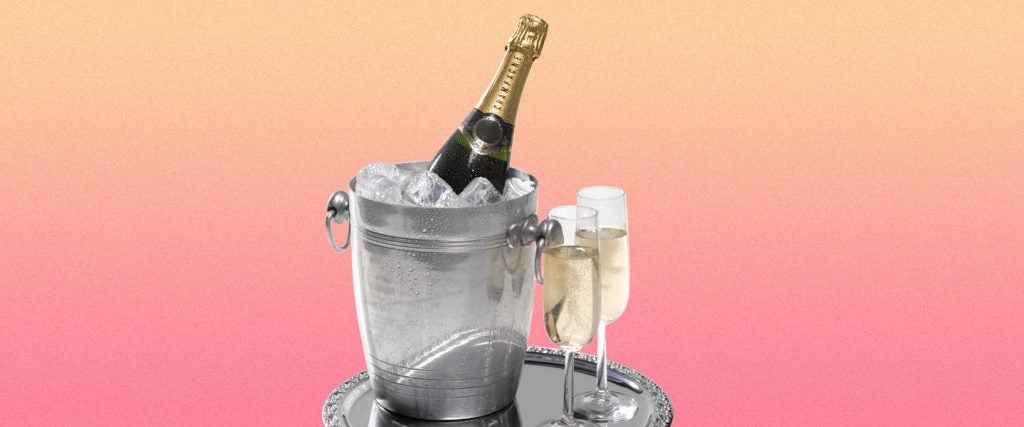You’re at the store, staring at a refrigerated case of sparkling wines. The very best are upwards of $50 a bottle; even mid-tier options seem to hover around the $20 mark. Then, you turn around and notice the shelf full of discounted bottles of Cook’s and André, and begin to wonder: Hey, I like $7 bottles of regular wine just fine — can’t I just take cheap bubbly and doctor it up to make it taste more expensive?
As long as there’s been booze, imbibers have invented their own ways of taking something unremarkable, or downright nasty, and improving it with DIY efforts. I remember watching friends in college use Brita water pitchers to charcoal-filter Prestige vodka (which came in a plastic jug and tasted like liquid butane), claiming it would make it smoother. Others claim that you can fix up bad whiskey by blending in a shot from a nicer bottle, or improve a mediocre pint of light beer by infusing it with a dash of bitters.
But sparkling wine is a delicate drink that’s not so easy to experiment with, unless you’re willing to just make a cocktail with it. It’s produced by pressing and fermenting grapes into a still wine, and then putting the liquid through a second fermentation with yeast and sugar to create fizz, either in the bottle (the “méthode champenoise”) or in a large tank.
The complexity of this process means that there’s more that can go wrong than with still wine production, which is why cheap sparkling wine can turn out blatantly flawed, whether it’s far too sweet, too fizzy, ripe with unpleasant aromas, astringent and bitter or just plain incohesive. Predictably, the root of the issue is the use of mediocre grapes, says Tom Gendall, director of winemaking and viticulture at well-respected Sonoma winery Cline (which makes, among other things, a craveable sparkling wine).
“Cheaper sparkling wines typically have a lot of sugar and become overly sweet or cloying. This is done at the winery to enhance the fruity character — generally, cheap wines lack a depth of fruit, so adding sugar enhances any fruit you do have, and adds mouthfeel to make the wine feel richer or more full-bodied,” Gendall explains.
Watch any taste-test of cheap bubbly by a reputable wine expert, and you start to see that fatal flaw come up over and over again. As winemaker and sommelier Patrick Cappiello observes in his review, it’s overall tough to find good-value labels in the sparkling wine genre. This is in contrast to other kinds of wine; there’s a delicious $12 pinot noir to be found in basically any decent wine shop, for example. “There are a few more steps that go into making sparkling wine, and if corners are cut for the end result of getting bubbles in it, sometimes you’re going to sacrifice other things that make wine delicious to drink,” Cappiello concludes.
So is there anything you can do to doctor up a bad bottle of bubbly? I hoped Gendall might have some magic winemaker’s trick to offer, but instead, his assessment was blunt: “It’s a bit of a dead end.”
Adding flavorings to offset the flaws in a sparkling wine is a common tactic; online, some sources suggest a tiny squeeze of lemon into a glass of flabby sparkling wine. Gendall thinks that could help bad bubbly by boosting acidity, tempering sweetness and adding more fruit character, but you can also easily imagine how it might just lead you to a bad glass of lemony wine. And in general, the bubbly nature of sparkling wine makes it tricky to doctor. “If you filter or manipulate the sparkling wine too much, you will strip it of its bubbles, making it appear even sweeter and more cloying, so I wouldn’t recommend that,” Gendall says.
(Hoping to experience a miracle, I bought bottles of Cook’s and Freixenet, an affordable cava, wondering if a hit of lemon would do anything. It helped the former, which is sickly-sweet to begin with, and did nothing for the latter, which makes sense — Freixenet Brut is already quite dry by design.)
The truth of the matter is that wineries already use a lot of tricks to take so-so grapes and make cheap bubbly taste “as good as it’s going to get,” Gendall notes. The real trick is to budget a little bit higher and avoid real-deal bottles from the Champagne region of France; because of its protected origin and extra processing, true champagne tends to be far pricier compared to prosecco, cava and other sparkling wines.
That’s why there’s no shame in using bad bubbly for all kinds of great cocktails, whether it’s a French 75, a Kir Royale or an Aperol Spritz. All of these drinks thrive by using other intense liqueurs and juices to bury the flaws of so-so bubbly, using it as a dancing partner to other flavors rather than a solo show. There’s endless flexibility in how you can experiment with the basic formula of sparkling wine + liqueur + mixer, whether you’re a newbie at the home bar or fancy yourself an elite mixologist.
Sometimes, things are more expensive because the right way of making it simply costs more. There’s a lot of hype and profit in the luxury booze market, but when it comes to cutting costs for your champagne, it’s still a story of buyer beware.

